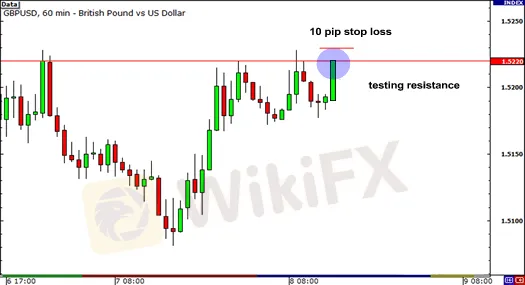简体中文
繁體中文
English
Pусский
日本語
ภาษาไทย
Tiếng Việt
Bahasa Indonesia
Español
हिन्दी
Filippiiniläinen
Français
Deutsch
Português
Türkçe
한국어
العربية
Setting A Stop Loss Based On A Percentage Of Your Account
Abstract:Let's begin with the most fundamental sort of stop loss: the percentage-based stop loss. The percentage-based stop employs a portion of the trader's money that is predefined.
Let's begin with the most fundamental sort of stop loss: the percentage-based stop loss.
The percentage-based stop employs a portion of the trader's money that is predefined.
For instance, a trader's willingness to risk “2% of the account” on a deal.
The percentage risk varies depending on the trader. More active traders risk up to 10% of their account, while less aggressive traders often risk less than 1% every trade.
After determining the percentage risk, the forex trader utilises his position size to establish how far out from his entry he should set his stop.
Isn't this great?
A trader is establishing a stop that is consistent with his trading strategy.
Isn't this good trading?
WRONG!!!
Always set your stop loss based on the market or your system's criteria, not on how much money you want to lose.
We're sure you're wondering right now. That is incomprehensible. “I thought you said we needed to manage risk,” I remarked.
We agree that this is perplexing, but allow us to clarify with an example. Don't you remember Newbie Ned from your Position Sizing class?
Ned, a newbie, has a $500 micro account with a 10k unit minimum trade size. Ned, a newbie, chooses to trade the GBP/USD since he notices that resistance at 1.5620 has held.
Ned will risk no more than 2% of his account per deal, according to his risk management standards.
Each pip is worth $1 at 10k GBP/USD units, and 2% of his account is worth $10.
Ned may set a stop loss of up to 10 pips, which he does on this trade by setting his stop at 1.5630.

GBP/USD, on the other hand, fluctuates around 100 pips every day! He might be stopped out at the tiniest change in the GBP/USD.
Because of the position restrictions in his account, he is putting his stop loss based entirely on how much he wants to lose rather than the current GBP/USD market circumstances.
Let's have a look at what occurs next.

And then, wham! Because his stop loss was too tight, Ned was stopped out right at the top! Aside from the fact that he lost this trade, he also missed out on a chance to make nearly 100 pips!
As you can see from that example, utilising percentage stops has the disadvantage of forcing the forex trader to set his stop at an arbitrary price level.
Either the stop will be too near to the entrance, as in Newbie Ned's instance, or it will be at a price level that ignores technical analysis.
You might be putting your stop just at the point that the price turns and heads in your direction (who hasn't seen it before?).
But you wouldn't be able to bag those pips since you'd already been stopped out! Oh, no!
Ned's answer is to find a broker that matches his trading style and initial money.
Ned should use a forex broker that permits him to trade micro or even bespoke lots in this scenario.
Each pip is worth $0.10 at 1k GBP/USD.
To keep within his risk tolerance, Ned might put a stop loss on the GBP/USD at 100 pips before losing 2% of his account.
The formula is as follows: 100 pips x $0.10 Equals $10.
He may now tailor his stop to the market situation, trading strategy, support and resistance levels, and so on.
Disclaimer:
The views in this article only represent the author's personal views, and do not constitute investment advice on this platform. This platform does not guarantee the accuracy, completeness and timeliness of the information in the article, and will not be liable for any loss caused by the use of or reliance on the information in the article.
Read more

Forex is a game that I enjoy playing
These champions have one thing in common: they not only work their butts off, but they also enjoy what they do.

Wait patiently. Maintain your discipline
"Patience is the key to everything," American comic Arnold H. Glasgow once quipped. The chicken is gotten by hatching the egg rather than crushing it."

There isn't a Holy Grail to be found!
Ask any Wall Street quant (the highly nerdy math and physics PhDs who build complicated algorithmic trading techniques) why there isn't a "holy grail" indicator, approach, or system that generates revenues on a regular basis.

Concentrate on the Process. Profits aren't a priority
We've designed the School of WikiFX as simple and enjoyable as possible to help you learn and comprehend the fundamental tools and best practices used by forex traders all over the world, but keep in mind that a tool or strategy is only as good as the person who uses it.
WikiFX Broker
Currency Calculator







